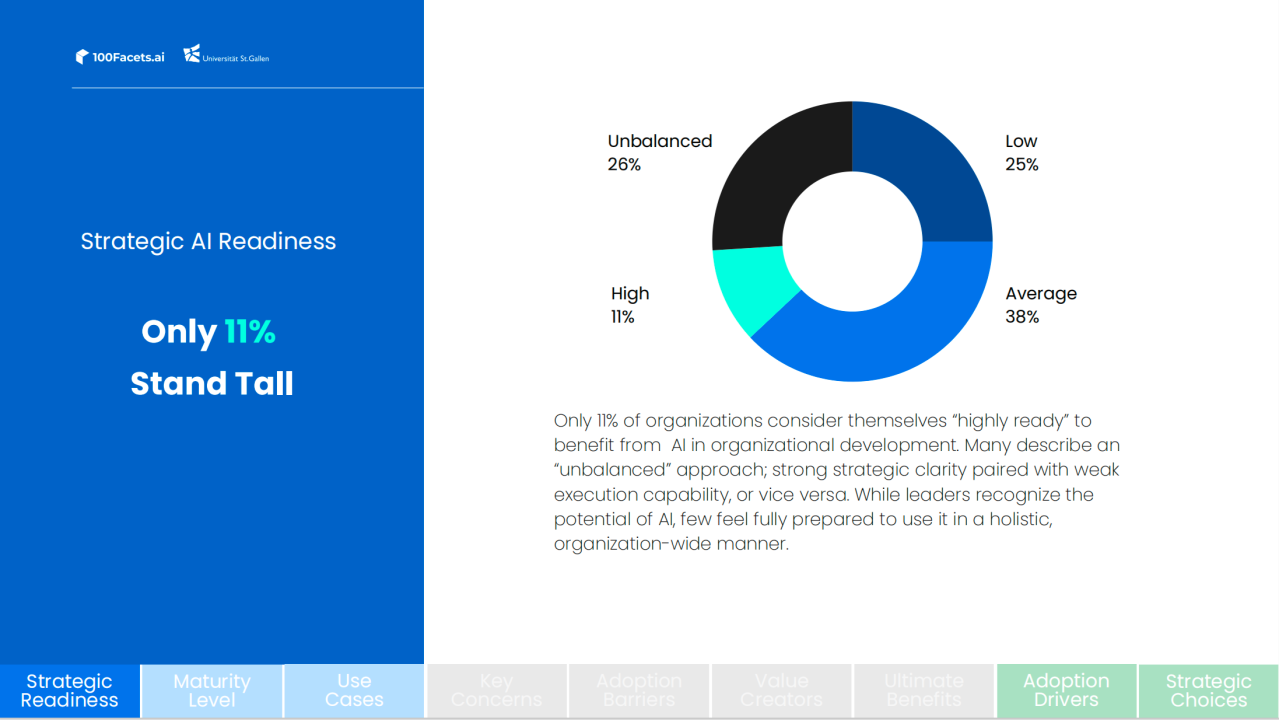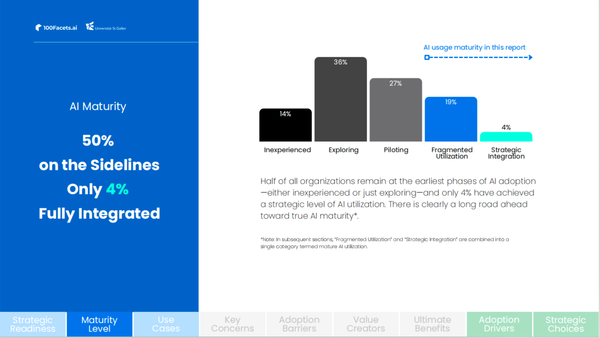AI is high on every agenda, but low when it comes to readiness – Insights from our research with 155 senior leaders

By now, everyone from the boardroom to frontline teams is talking about AI. Yet new research from 100facets.ai , in partnership with the University of St.Gallen (HSG) – Executive School , shows that while AI dominates executive agendas, most organizations are far from being genuinely prepared. We surveyed 155 senior leaders in HR, L&D, and the C-suite, uncovering three critical truths:
1. Perception Gap: A Consultancy Dream, but Organizational Nightmare
CxOs rate their organizations’ AI readiness almost five times higher than HR and L&D teams do. On paper, this is great news for consultants, who can expect eager clients. But it’s alarming for organizations themselves. This distorted internal view undermines the basis for any strategic AI discussion—because if senior leadership thinks everything is on track while frontline teams see major hurdles, genuine alignment is impossible.
In a recent webinar we hosted with about 50 senior leaders, many admitted that while they feel external pressure to have all the “AI answers,” they’re still learning themselves. Meanwhile, employees sense that top management isn’t grasping day-to-day complexities. The result? More frustration, stalled momentum, and a higher risk of big-budget consulting projects that fail to deliver lasting results. A better path is to seek concise expert guidance but quickly build internal capabilities—rather than depend on never-ending external support.
2. Only 11% Ready, 1 in 4 “Flying With One Wing”
Our study found only 11% of organizations truly consider themselves ready to leverage AI in workforce development. Equally striking: 1 in 4 is “flying with one wing,” meaning they either have strong strategic clarity but no real execution power, or a capable operational team without a unifying AI strategy.

Without bridging that gap, organizations risk investing in AI pilots that never scale—or building neat strategies that never see daylight. It’s a lose-lose scenario. To move forward, leaders must get the entire organization onto one page, ensuring robust strategic direction is paired with the practical know-how to execute.
3. Small Firms Surging Ahead
Small organizations are 2.5 times more likely to have robust AI readiness than their larger counterparts. Their advantage? Agility, fewer internal silos, and the ability to pivot quickly. This is an immense opportunity for smaller companies to punch above their weight and carve out a distinctive edge.
For medium and large enterprises, the risk is equally clear. If they don’t address organizational misalignments fast, they could find themselves outmaneuvered by nimbler players. The focus should shift to unifying strategy with hands-on execution—ensuring each division, team, and leader aligns on where AI fits and how to roll it out effectively.
Bottom Line: AI might be on every executive’s lips, but true readiness demands much more than enthusiasm at the top. It requires real alignment across the enterprise, an honest appraisal of internal capabilities, and selective use of expert consultants who can catalyze—rather than outsource—your company’s AI evolution. You can (probably should) use AI tools that are developed by experts in specific domain (for example we have been serving top business school and companies in Switzerland and Europe with our suite of advanced AI tools for HR, OD and Learning professionals at 100facets.ai), but I won't recommend letting others decide for you where and how to use AI to grow or defend your business. That is too important of a topic to you to leave it to others to decide on your behalf.
Are you comfortable with where your organization stands? If not, now is the time to act.




